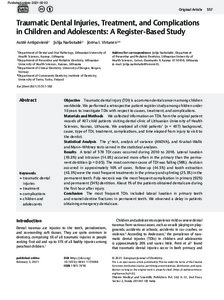Traumatic Dental Injuries, Treatment and Complications in Children and Adolescents: A Register-Based Study
Virtanen Jorma I; Narbutaitė Julija; Antipovienė Austė
https://urn.fi/URN:NBN:fi-fe2021042824631
Tiivistelmä
Objective: Traumatic dental injury (TDI) is a common dental concern among children worldwide. We performed a retrospective patient register study among children under 18 years to investigate TDIs with respect to causes, treatment, and complications.
Materials and methods: We collected information on TDIs from the original patient records of 407 child patients visiting dental clinic of Lithuanian University of Health Sciences, Kaunas, Lithuania. We analyzed all child patients' (n = 407) background, cause, type of TDI, treatment, complications, and time elapsed from injury to visit to the dentist.
Statistical analysis: The χ 2-test, analysis of variance (ANOVA), and Kruskal-Wallis and Mann-Whitney tests served in the statistical analyses.
Results: A total of 579 TDI cases occurred during 2010 to 2016. Lateral luxation (19.8%) and intrusion (14.8%) occurred more often in the primary than the permanent dentition (p < 0.05). The most common cause of TDI was falling (56%). Avulsion occurred in approximately 10% of cases. Follow-up (44.5%) and tooth extraction (48.3%) were the most frequent treatments in the primary and splinting (25.3%) in the permanent teeth. Pulp necrosis was the most frequent complication in primary (92%) and permanent (54%) dentition. About 1% of the patients obtained dental care during the first hour after injury.
Conclusion: The most frequent TDIs included lateral luxation in primary teeth and enamel-dentine fractures in permanent teeth. We observed a delay in patients obtaining emergency dental care.
Kokoelmat
- Rinnakkaistallenteet [19218]
